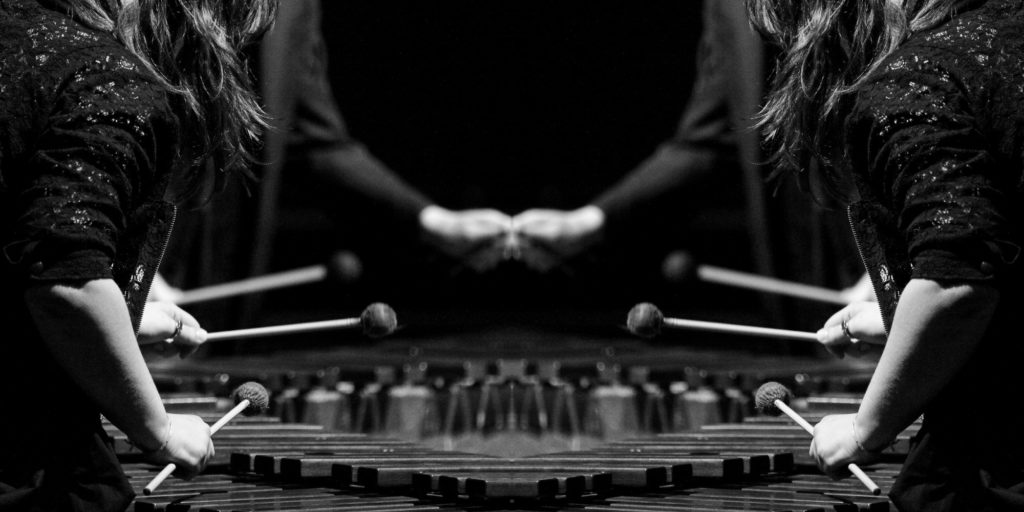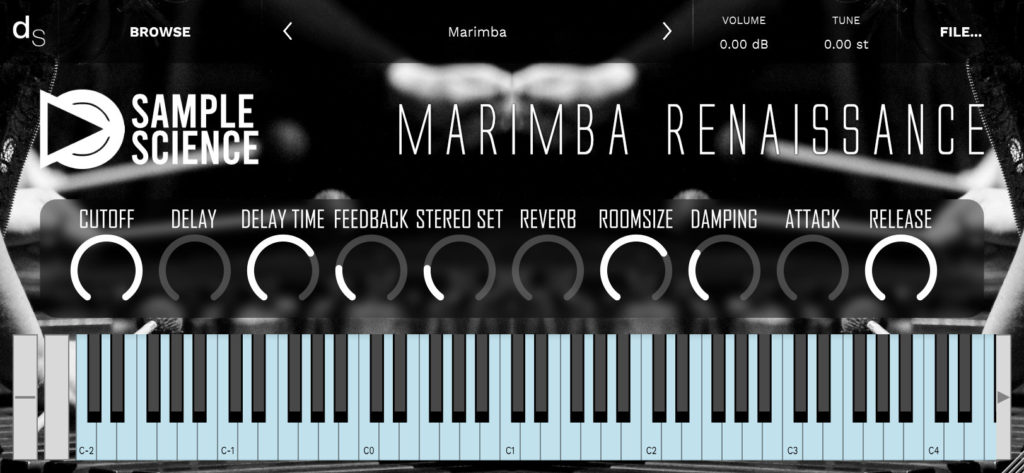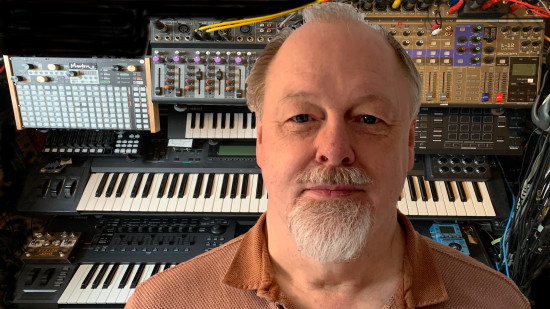
The story
Marimba Renaissance is a virtual instrument based on a damaged marimba recording that has been restored.
Found in the public domain, the recording is very lo-fi and noisy.
A combination of audio engineering techniques has been used to make this recording sounds great: spectral repair, adaptative noise removal, manual retuning, and physical modeling.
The instrument is provided as a Decent Sampler library with two presets: standard and space.
Marimba Renaissance audio demo
Interface

Reviews for Marimba Renaissance
Leave a review to let others know what you thought of the instrument!
The bassiest marimba!?
This is not your everyday marimba. It's deeply sampled, it's bassy and very responsive, but what makes it different than others is its range and placement. It is available on the entire keyboard, yet it is set in a way like it's meant to be played as a bassy pluck for an EDM track. If your keyboard has a handy octave button, you might be able to reach some regular mids on the last top octaves (C7-G8).
The GUI is simple, straightforward, clean-looking and very handy, offering an LFP, Delay, Reverb, Attack and Release settings. All in all it's great, so if you are looking for a nicely sampled marimba with a nice low range, this is pretty much it.
The Invisible Marimba!
The perfect restoration is one that you don't notice. Invisibility, you might say. Well, the story for this virtual instrument spills just enough details to whet my appetite, and then leaves it to the audio to continue the story-telling.
I love the sound of a Marimba. Well, to be precise, I especially love it in the two octaves around C6. Go too far above that and they tend to sound strange and lose resonance. Too far below that and they become woody and hollow in sound. But this is solely my problem, and not connected with this amazing instrument, but at least I have revealed my bias - oh, and don't get me started on triangles and pitch...
There's a strong clue in the name of the simplest: SampleScience! But what I struggled with was finding something to criticise - despite the array of technology mentioned in the story, all I could hear was a marimba! Huge kudos to anyone who tells you 'up front and centre' that the sound has been processed, and ginormous cognitive dissonance when your traitorous ears keep whispering 'sounds fine to me'...
The curious side of me wants to hear what the originals sounded like. The sensitive side of me doesn't want to ever hear what the originals sounded like. Luckily, all I can hear is a marimba, close up and personal. I loved it.
My step sequencers are a bit pickier than I am. There's something about precise repetition that can highlight some inconsistencies that a human being just noodling may well miss. So there's something in the low frequencies that seems a little boomy sometimes - maybe a little more high-pass filtering here and there? The G#4 is curiously muted as well, but hey, me and my sequencers are a difficult test audience.
It may be by design, but I noticed that the stereo positioning moved around, rather than following the physical arrangement from left to right. When the overall sound is close up and intimate, as this is, then my head tends to prefer a boring left-to-right progression with pitch. Whilst we are talking stereo, then the 'Stereo Set' rotary control caught my eye, but it is actually just the stereo offset in the Ping-Pong Delay effect, so yes, it does affect the stereo image, but only in the delay... And now I feel very cruel for being a nit-picking monster reviewer.
Positives now! I always love it when samplists use all of the available range of the keyboard. I always tweak any presets that restrict the range, but there was no need to do that here! Admittedly, there is only one source sample for C4 and below, and C8 and above, but in-between, we have chromatic samples! (oh, and no round robins, and no dynamic velocity layers, but I didn't notice until I went digging in the XML...) Sometimes you are distracted by the sound, and the technical details don't matter. (Remind me about this the next time I start to become a monster reviewer!)
There are two presets: 01 Marimba is...a Marimba! 02 Space Marimba is exactly what I would have done: it adds ping-pong echo! But better than that, it adds echo to samples that already have repeated hits in them - so you can get all sorts of wonderful syncopation effects if you want. Both presets avoid my usual flaw - they have no added reverb. Full marks for resisting that!
Improvements... The UI is crisp and clean, and my only thought is that I might be tempted to make the parameter controls slightly smaller than the mix controls, so that I know where the 'Delay' and 'Reverb' mix rotary controls are without having to scan across lots of controls. But feel free to ignore/discount my opinion - after all, I'm that crazy guy who puts too many sliders all over his virtual instruments!
(It would be nice if MIDI Controllers were mapped to a few parameters... Whenever I balk at doing this task, I just summon up a mental picture of Christian Henson's fingers riding the sliders on his MIDI Controller, and then him pointing excitedly to the automation lane in his DAW!)
If I like extended ranges of pitch, then I love envelopes, and the 'Attack' rotary control is a stroke of genius! If there's any one control that can completely transmogrify a marimba, then an 'Attack' control is most definitely it! Slow marimbas are a very good 'characterful' alternative to the rather sterile Theremin (Oops, another secret revealed!), and if you slow the attack of the repeated hits of the Space Marimba, then you get a very 'Evelyn Glennie' fade-in effect, which I have always loved.
Conclusion: Loved the sound. Loved the invisible technology that makes it possible for us to hear the sound. Loved the persistence and effort that was obviously required to get this onto Pianobook.co.uk. That's a lot of love!


